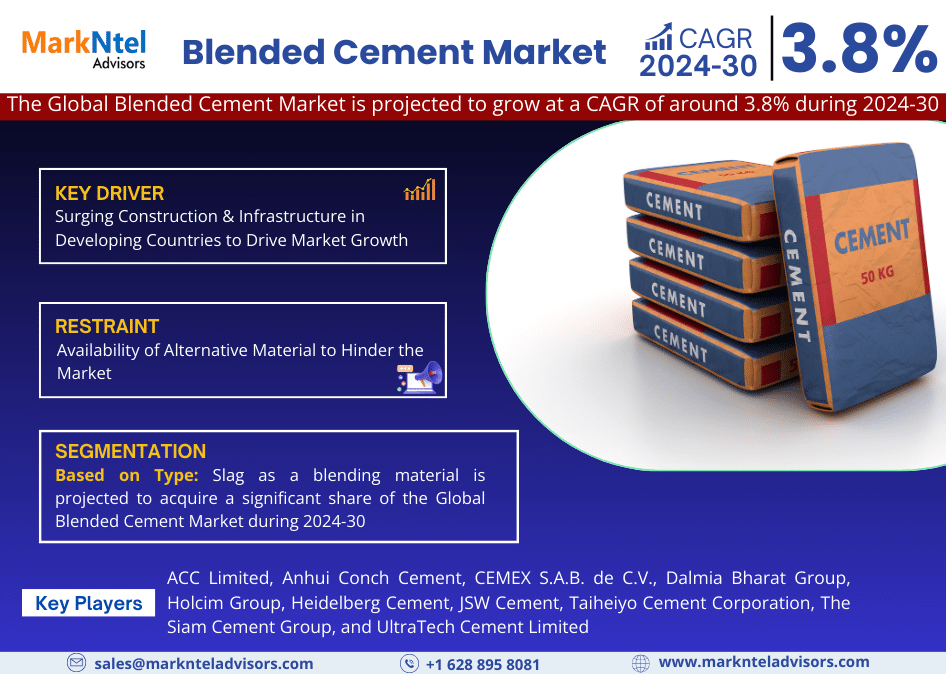Press Release Description
Blended Cement’s Demand to Mount Due to Increasing Sustainable Building & Construction Globally
The Global Blended Cement is projected to grow at a CAGR of around 3.8% in the forecast period of 2024-30, cites MarkNtel Advisors in their recent research report. The market of blended cement would increase due to the boosting construction, infrastructure, and surging urbanization owing to the rising population and huge investment by governments for building projects related to infrastructure, such as roads, airports, bridges, tunnels, dams, etc., across the countries.
As awareness and government regulations are increasing for eco-friendly & non-toxic, like carbon emissions in construction buildings and infrastructure, many countries are focusing on the manufacturing of blended cement, such as India, Malaysia, Nigeria, etc., with the booming demand for blended cement. Thus, it is anticipated that in the upcoming years, the demand for blended cement would mount across the world.
Additionally, rising urbanization & a growing number of residential buildings, coupled with the flourishing tourism sector leading to rapidly rising construction of commercial infrastructures like roads, hotels, healthcare facilities, shopping malls, trade centers, and corporate spaces, are all driving the construction industry and, in turn, augmenting the growth of the market, further states the research report, “Global Blended Cement Analysis, 2024.”

Global Blended Cement Market Segmentation Analysis
Slag to Dominate the Blended Cement Market Through 2030
Based on type, the market is fragmented into Silica Fume, Fly Ash, Slag, and Limestone. Slag is predicted to dominate the Blended Cement Market during the forecasting period. With ever-increased requirements for continuous access to quality & eco-friendly materials and energy trends shifting away from coal-fired plants, the availability of fly ash is significantly reducing, and slag-based blends that have superior durability, versatility, strength, and low heat of hydration are gaining ground globally.
Slag-based blended cement has high flexural & compressive strength, enhanced workability, fewer risks of cracking, a premium finish, and a long service life. As a result, it is considered ideal for environmentally friendly infrastructure projects and allows for exceptional housing facilities. Hence, various ongoing & upcoming commercial & residential construction projects across different countries due to burgeoning population rates & urbanization are projected to accelerate the demand for slag blends.
Asia-Pacific is the Largest Blended Cement Industry Globally
Asia-Pacific is the largest user across the Global Blended Cement Market, where China dominates the region. Notably, developed nations like Vietnam, India, and Indonesia present promising prospects within this market. This is fueled by significant governmental investments in smart city initiatives, the surge in population, rapid urbanization in China and India, and the enhancement of disposable incomes.
Following China, India emerges as the market's leader due to its status as the world's most populous country, with forecasts predicting significant population expansion during the anticipated period. This expansion provides potential for mixed cement in the construction of residential and housing developments.
Aside from China and India, Vietnam and Indonesia also contribute considerably to the region's consumption of blended cement. This is mostly owing to the rapid expansion of infrastructure development activities, which includes projects, including railways, bridges, roads, dams, power plants, and different transportation and energy infrastructure efforts.
Competitor Landscapes –
With strategic initiatives, such as mergers, collaborations, and acquisitions, the leading market players, including ACC Limited, Anhui Conch Cement, CEMEX S.A.B. de C.V., Dalmia Bharat Group, Holcim Group, Heidelberg Cement, JSW Cement, Taiheiyo Cement Corporation, The Siam Cement Group, and UltraTech Cement Limited, and others, are looking forward to strengthening their market position.
Key Questions Answered in the Research Report
- What are the industry’s overall statistics or estimates (Overview, Size- By Value, Forecast Numbers, Segmentation, Shares)?
- What are the trends influencing the current scenario of the market?
- What key factors would propel and impede the industry across the region?
- How has the industry been evolving in terms of geography & product adoption?
- How has the competition been shaping across various countries?
- How has the buying behavior, customer inclination, and expectations from product manufacturers been evolving during 2019-30?
- Who are the key competitors, and what strategic partnerships or ventures are they coming up with to stay afloat during the projected time frame?
We offer flexible licensing options to cater to varying organizational needs. Choose the pricing pack that best suits your requirements:
Buy NowNeed Assistance?
WRITE AN EMAIL
sales@marknteladvisors.comCustomization Offered
100% Safe & Secure
Strongest encryption on the website to make your purchase safe and secure
